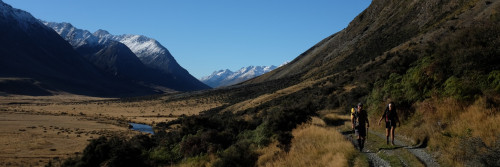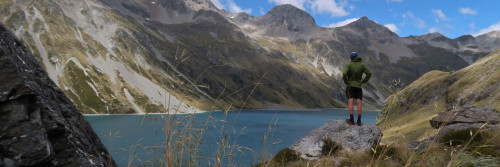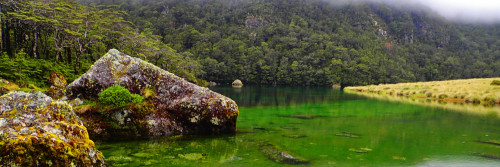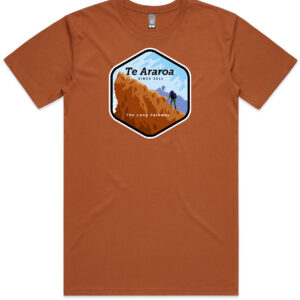News and media
Retro-walker
He was a pioneering publisher, but he became known finally as the man who
walked. Very fit. Very popular. Very old. At the age of 99, A H Reed
signed off his last walking book 'The happy wanderer' with the hope that
in some heavenly sphere he'd renew his youth, and find himself "still on
the road, living actively in a new world of wonders."
That wish is here somewhat obliquely granted. With re-publication of 'The
Four Corners of New Zealand' (New Holland Press, RRP $34.95), we catch the wholly youthful septuagenarian
walking the back-country as ever, in a world that may indeed seem newly
wondrous.
The wondrous content, as one example, of the Reed haversack: one spare suit
wrapped in a flourbag, a cut-throat razor, strop, shaving soap, boot
polish and brush, pajamas, a small bottle of ink and a fountain pen, a
pair of slippers, a book, also pocket hymns and the new testament. This is
not New Zealand tramping as we know it.
Nor are his walking routes - with one rigorous exception - anything like
the traditional Kiwi tramp. Rather, they appear to be a culturally
specific form - the English rural walk. Transposed to New Zealand, the
purpose of AH's rural walk may remain pure, but there's a dreamlike skewing
of every other facet. Not byways but metalled roads, not kissing gates but
fences to straddle, not pathways but animal tracks, not signage but
ambiguous advice from locals. The walker gets bogged, follows cliff-side
trails that end in mid-air, and descends to the wrong beach. Bad weather
and darkness move in, as always, to aggravate the general discomfort. AH
seems to spend many nights in rainstorms, huddled under a tent fly.
But the purpose, we said, remained pure. William Wordsworth and the
romantic poets pioneered the expectations of the English rural walk - a
certain sublimity, a certain melancholy amidst the ivy-covered ruin of an
abbey, a certain mysterious joy arising, and AH settles for nothing less.
He's damn good on waves beating the New Zealand shoreline, he'll muse at
length on the mouldering history underfoot, be it an ancient pa or the
last hydrangea remnant of a pioneer house. And as to the mysterious joy
arising: well, the greatest of the American wilderness writers, John
Muir, brought an evangelical note to his natural descriptions too.
As a social observer though, AH is precise and interesting. In these
journals of the late 1940s and early 1950s, wounded soldiers still slowly
heal in sunny back yards, road menders still patrol their 7-mile section
of road, gum-diggers and hermits still forage around their huts, service
cars still raise a billowing dust plume between small towns, hotels still
serve toheroa soup, farmers still hand-milk in the byres and lug their
cream cans to roadside stalls.
And if AH's English-style country walks and his frequent recourse to the
English literary canon sits at a slightly eccentric angle to New Zealand's
tradition, the 8-day tramp described in 'Farthest West' is a breathtaking
induction to full-on tramping as we do sometimes know it. In 1950, the
route from the West Arm of Lake Manapouri to Dusky Sound was trackless,
and the warnings against attempting it dire, but in pursuit of his third
compass point, AH and his nephew AW Reed, set out anyway. Surrounded by the
hard rock, the spire-steep mountains, the chaos and old night that is
Fiordland, the two wade rivers, follow deer trails that criss-cross into
confusion, streams that deadend in impassable waterfalls, detour over
bluffs, descend the wrong face of Murrell Pass, crawl on all fours through
matted vegetation, suffer continual rainstorms and set up a tent fly that
bulges with rainwater basin-deep above their heads. They are assailed by
sandflies and mozzies, wrap their heads in netting, huddle in soggy
sleeping bags, exhaust their torch batteries, go lame, lose their camera,
sink waist-deep into quagmires, and watch their precious books turned to
pulp by the capillary creep of water into the centre of their packs. The
two become "cavemen" - about as far as Reed's delightfully restrained prose
will go in describing a degeneration that veers towards genuine emergency.
The journey would be a stern test for any tramper. Its undertaking in 1950
by a 74 year-old, in company with his 42 year-old nephew is astonishing.
One begins to see how the somewhat shy and circumspect AH Reed attained his
place in the pantheon of New Zealand folk heroes. He was raised in rough
circumstance from the age of 11. His English family arrived in 1887, down
on its luck, and for years the family lived in Northland shacks. At age 12
AH developed osteo-myelitis so badly in one leg that doctors contemplated
amputation. He recovered, spending years as a young man working on the
gum-fields and the roads, breaking out of the working class later, but
never losing his interest in Maori life, pioneer struggle, the lonely hut,
and the New Zealand bush. His publishing was a proclamation of that same
vernacular worth - books the metropolitan culture might not find important,
books whose accuracy the university culture might question, but folk
history anyway, told by the people who'd lived it.
Reed's walking tours are a direct physical parallel to that publishing
style. Everywhere he seeks people's stories - Maori in particular.
Everywhere he layers the hills and valleys around him with the written
observation of past explorers, and pioneers. His walking and the writing
become, as a result, a deeply New Zealand enterprise, deliberately symbolic
- the four compass points of this present reprint, and the later walk from
North Cape to Bluff in 1962 make that plain. But Reed had long ago earned
his wings on that score. He was a natural patriot.
All of which might seem simply historic now. But the last beauty of the
walk, any walk, is its timelessness. AH notes the hot flat rock, or the
springy teatree against which he leans to rest, the billy he allows sinkage
into a cold pool, the drowsy hush of a landscape under a hot sun, the
circle of firelight at night. These are powerful simplicities, that sank
into New Zealanders' bones long ago. It's a fair bet that as we move into a
more complex urban age, we'll seek them all the more.
In this book, AH describes himself as "one of those cranks who go about the
country afoot because they like to do it." But forget crank, and maybe
call him a man who peaked too soon. Access across the countryside is
unrolling now because, much as happened in Britain, the urban crowd wants
it. New Zealand has always had generous amounts of public domain - most of
it rugged, the realm of the tramper, the mountaineer and the out-of-doors
enthusiast. The country has lacked the more sociable and accessible
countryside walks, but councils are beginning to write such countryside
access into their plans. They, the Department of Conservation and many
Maori tribes are also supporting Te Araroa - the Long Path - the planned
2,900 kilometre hiking trail, across landscape of all types, the length of
New Zealand.
The prospect of such a walk didn't faze AH. In 1960, at age 85, he walked
from North Cape to Bluff. People clapped him through, brought him cups of
tea, waved and tooted from cars, screeched to a halt by the entire busload,
and along the route, class after class of school-children were gathered for
compulsory but unforgettable immersion in the eerie spell cast by this old
gaunt giant of early hiking. He was the kaumatua of countryside and of
distance walking in New Zealand, but even AH himself must finally yield to
another, more anonymous figure.
The solitary walker making its way through the landscape, reliant only upon
the strength of body and will, is one of the world's most compelling
images. When it rains the figure gets wet. When the sun comes out the
figure dries out. It's open to the sights and scents of the natural world,
open to companionship or not, and slowly but surely it covers its
distances. It's humankind gone simple. It's always been there, but from
time to time we forget what it's like, and so tend to celebrate that
walker who again dons the ancient mantle - sorry the oilskin, or, come to
think of it, the Gore-tex coat - and steps out into the world. But the way
is open, of course, to everyone.
Geoff Chapple



